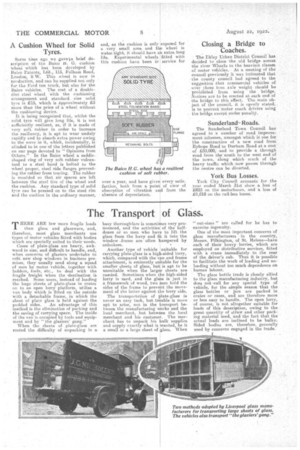The Transport of Glass.
Page 8

If you've noticed an error in this article please click here to report it so we can fix it.
THERE ARE few more fragile loads than glass and glassware, and, therefore, most glass merchants use types of motor vehicles fitted with bodies which are specially suited to their needs.
Cases of plate-glass are heavy, awkward in size, and difficult to handle, and, when concerns of glaziers undertake to refit new shop windows in business premises, they usually send along a squad of men by motor vehicle, together with ladders, tools, etc., to deal with the fragile freight when the -destination it reached. Some users, instead of loading the huge sheets of plate-glass in crates on to an open lorry platform, utilize a van body which is fitted on the outside with a detachable frame, in which the sheet of plate glass is held against the
padded sides. Au advantage of this method is the elimination of parking and the saving of carrying space. The inside of the van is occupied by tools and equipment and by "the glaziers' gang."
When the sheets of plate-glass are crated the difficulty of unpacking in a busy thoroughfare is sometimes very pronounced, and the activities of the halfdozen or so men who have to lift the glass from the lorry and fit it into the window ,frame are often hampered by onlookers. • Another type of vehicle suitable for carrying plate-glass is a high-sided lorry, which, compared with the van and frame attachment, is eminently suitable for the smaller sheets of glass, but is apt to be unsuitable when the latger sheets are carried. Sometimes when t e high-sided lorry is used, and the glas is just in a framework of wood, two zien hold the sides of the frame to prey t the movement of the latter against the lorry side.
The transportation of plate-glass is never an easy task, but trouble is more apt to arise, not in the transport between the manufacturing works and the local merchant, hut between the local merchant and his customer. The merchant has to unpack his bulk supplies and supply exactly What is wanted, be it a small or a large sheet of glass. When
" out-sixes " are called for he has to exercise ingenuity.
One of the most important concerns of glass manufacturers in the country, Messrs. Pilkington, of St. Helens—have each of their heavy, lorries, which are employed on distributive services, fitted with a crane immediately to the rear of the driver's cab. Thus it is possible to facilitate the work of loading and unloading without too much dependence on human labour.
The glass bottle trade is closely allied to the glass manufacturing industry, but does not -call for any special type of vehicle, for the simple season that the glass bottles or jars are packed in crates or cases, and are therefore more or less easy to handle. The open lorry, of course, is not altogether suitable for loads of this description, owing to the great quantity of straw and other packing material used, and the fact that the actual loads are inclined to be bulky. Sided bodies are, therefore, generally used by concerns engaged in the trade.


































